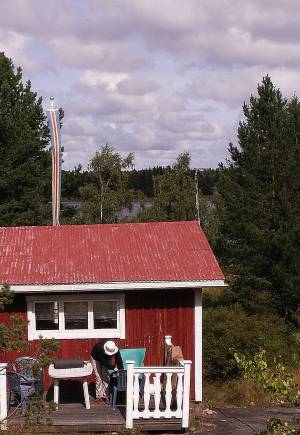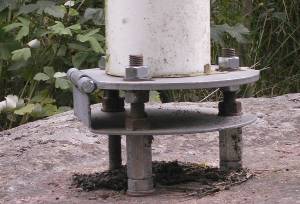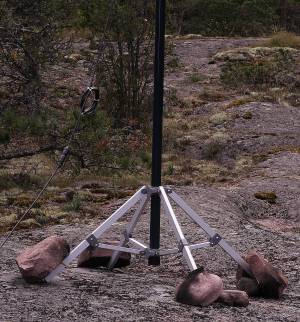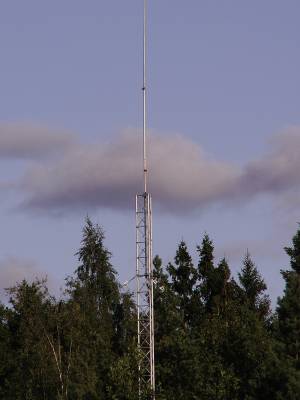
QRV auf den Ålandinseln |
|
For the English version see below! Wo soll der nächste Sommerurlaub hingehen? Und zwar so, dass sowohl die Familie, als auch das Hobby, zu ihrem Recht kommen? Die Åland-Inseln (Landeskenner OH0) sind da nicht die schlechteste Wahl. 
Warum die Ålandinseln?Natürlich gibt es Zeitgenossen, für die geht nichts über Ballermann. Funkamateure dürften da aber unterrepräsentiert sein. Eher dürfte in DL ein anderes Anforderungsprofil vorherrschen:
Wer auf die Schulferien angewiesen ist, muss für südliche Länder schon ausgesprochen hitzeresistent sein und gerne eine Siesta machen. Nach Norden zu fahren kommt Vielen aber nicht in den Sinn: Da gibt's doch nur Mücken und kalt ist's auch! Wer aber mit Skandinavien-Kennern redet, hört etwas anderes: Natürlich gibt es zu bestimmten Jahreszeiten und in bestimmten Gegenden riesige Mückenschwärme. Jeder, der unbedingt die Mitternachtssonne am Nordkap erleben musste, kann das bestätigen. Aber wenige Wochen später, wenn also vor allem die südlichen Bundesländer Schulferien haben, sieht das schon wieder deutlich anders aus. Auch das mit den Temperaturen sollte man differenziert sehen: Natürlich ist die Sonneneinstrahlung weniger intensiv, aber dafür scheint die Sonne um so länger. Und wenn man nach Finnland fährt, ist das alles sowieso kein Thema mehr: Abends heizt man die Sauna (auf den schwedisch-sprachigen Åland-Inseln: Batu) an und schon ist es einem heimelig warm. Für die Kinder und den OM ist noch etwas wichtig: Es gibt beliebig Platz. In den Reisekatalogen sind regelmäßig die Abstände zum Nachbarhaus angegeben und 100 m sind da nichts Exotisches – je weiter man nach Osten und Norden kommt, um so weniger. Die Åland-Inseln haben dabei ein paar spezielle Vorteile:
Ein paar Tipps zum Funkbetrieb auf OH0
AntennenbauDen Platz habe ich schon erwähnt – da gibt es 5000 m2 große Grundstücke mit Seezugang für 30.000 EUR. Allerdings können auf den Ålandinseln nur Einheimische Land kaufen. Sonst hätten da sicher schon längst die benachbarten Schweden die Preise hochgetrieben und die Gegend mit viel mehr Häusern vollgestellt. Wenn das Nachbarhaus 100 m oder noch weiter weg ist, ist das mit der Antennengenehmigung auch kein Thema. Leider hat man's als Besucher nicht so leicht wie die Einheimischen, die auch für hohe Masten keine Fundamente bauen müssen: Der typische Untergrund ist gewachsener Fels mit einer dünnen Humusauflage. Da setzt man einfach die Bohrmaschine am Fels an und schraubt den Mast fest. 
Für den Besucher bedeutet der Untergrund aber, dass er seine Erdanker gleich daheim lassen kann. Mit etwas Glück findet man immerhin einen ebenen Standplatz für den Mastfuß. Recht gut macht sich die Kombination aus einem 8-m-Fiberglasmast mit einer Groundplane für 20 m: Die Radials gehen in 3 m Höhe vom Mast ab, stabilisieren den Mast, und können (möglichst tief) am umgebenden Gebüsch festgemacht werden. Strahler und Radials waren bei mir übrigens 5,10 m lang und das SWR war über das ganze Band einwandfrei. Zu weitergehenden Untersuchungen hatte ich keine Lust – schließlich war ich im Urlaub! Wenn die Radials, so wie hier, nicht auf dem Boden liegen, reichen übrigens vier Radials völlig aus. 64 oder noch mehr Radials sind technisch nur nötig, wenn man sie unter dem Gras im Garten verschwinden lassen will. Allerdings müssen das vier Radials pro Band sein, da nutzt auch eine Matchbox nicht viel: QRP auf 20 m lief mit der oben beschriebenen Antenne recht gut, aber schon auf 10 MHz half alles Rufen nichts. In der Literatur findet man auch Hinweise, man könne die Radials mit einer gemeinsamen Verlängerungsspule auch auf niedrigeren Bändern resonant machen. Funkbetrieb
Habe ich schon erwähnt, dass man auf den Ålandinseln Ruhe findet? Das gilt auch für die Kurzwellenbänder: Als erstes habe ich den Mithörton meines TRX leiser gedreht. Auf OH0RAA auf 145,675 MHz habe ich natürlich gerufen, aber nie eine Antwort bekommen. OK, das war immer nur vom Auto aus und so oft waren wir nicht unterwegs. Diese Ruhe ist übrigens ein Argument gegen QRP-Betrieb: Man ärgert sich, weil man so viel hört, bei dem sich das S-Meter schon lange nicht mehr rührt, und nicht hin kommt. Schließlich muss man das QRM und QRN bei der Gegenstation übertönen – diesen Effekt beschreibt auch DL5XL für die Antarktis [1]. Auch sollte man nicht vergessen, dass man deutlich nördlicher ist als in Deutschland und das tut den meisten Ausbreitungspfaden nicht unbedingt gut. Das Gedränge nach dem vergleichsweise seltenen Land hatte ich mir übrigens schlimmer vorgestellt. Wenigstens mit meiner QRP-Station habe ich kein Pile-Up ausgelöst. Das liegt auch an den einheimischen OMs und diversen Contestmannschaften vom finnischen Festland. Ein OM meinte zu mir, nur noch OH0A sei allein in einheimischer Hand. Er selber mache eine große Anzahl an CW-Verbindungen und klagte über die vielen QSL-Karten, die er dafür schreiben müsse. Wenn man mit Afu-geübten Augen auf den Ålandinseln unterwegs ist, findet man eine Menge Amateurfunkantennen. Die lokalen OMs nutzen also ihre Möglichkeiten durchaus – etwa mit der 80-m-Vertical im Bild rechts am Wochenendgrundstück eines OMs. Aber wenn weniger OMs ein ganzes Land vertreten, als so mancher deutsche Ortsverband Mitglieder hat, dann bleibt das Land doch relativ selten. QRV On The Åland IslandsWhere to spend your next summer holidays – and do equal justice to your family and your hobby? The Åland Islands (country OH0) definitely are not the worst possible choice. 
Why The Åland Islands?Naturally there are people who need to get away from their job and enjoy the wild pleasures of partying and boozing. I could imagine that most radio amateurs have slightly different needs. Your list might look like this:
Families relying on the school holidays to take their Mediterranean vacation need to cope with the extreme heat from June to September and must enjoy taking siestas. Only few people consider traveling to northern Europe: Scandinavia is cold and populated with swarms of bloodthirsty mosquitos! But if you talk to people who have been there, you will hear a different story: True, there are seasons and certain areas where you feel like the central blood bank. Everyone whose quest in life was to see the midnight sun at the North Cap will agree to that. However, the situation improves vastly just a few weeks later. You should also consider the temperature issue from a different angle: The sun might not be as strong as in the south but it shines much longer. And if you go to Finland, the temperature is no issue at all – heat up the sauna (batu on the Swedish-speaking Åland Islands) in the evening and feel comfortably warm for hours. And another thing is very important: Space – all the space you could wish for the children and the OM. The travel brochures usually specify the distance to the next house, and distances of 100 m are nothing unusual – the less so the farther you travel to the north and east. The Åland Islands offer a few specific advantages in this:
A Few Tips About Operating From OH0
Setting Up AntennasI've already mentioned the space – real estate agents offer 5000 m2 properties directly at a lake for EUR 30.000. But only locals are allowed to buy real estate on the Åland Islands. Otherwise the neighboring Swedes would have driven up the prices long ago and crammed a lot more houses into the countryside. If the next house is 100 m or even further away, asking the owner about your antenna is not an issue. Unfortunately, you will have a few more problems than the locals with their permanent settings: They don't build any foundations even for their high masts. The typical ground is bedrock covered with a thin layer of humus. So they simply put their drilling machine to use and bolt their masts to the rock. 
This type of terrain means you can leave your ground anchors safely at home. With a bit of luck you might find a stable and horizontal place for the foot of your mast. I have had the best experience using an 8-m fiberglass mast and a 20-m ground plane antenna. The radials are connected to the mast at 3 m above ground, thus stabilizing the mast. The radials should be tied as low as possible to surrounding bushes. BTW: My radiator and the radials are 5.10 m long and the SWR was good all across the band. I did not investigate any further – I was on holiday, after all! If the radials are not on the ground as discussed here, four radials are easily enough. 64 or more radials are technically needed if you want them to disappear beneath the grass. But you will need four radials per band, and a matchbox is not of much use: QRP on 20 m worked quite well, but there were no replies on 10 MHz. You will also find a few notes in publications stating that you can resonate the radials on lower bands with a common inductor. Operation
Have I mentioned the absolute tranquility on the Åland Islands? This also applies to the shortwave bands – the first thing I did was to reduce the sidetone volume of my TRX. Of course I called on the local repeater OH0RAA on 145,675 MHz but never got any reply. OK, I only called from the car and we did not drive around that much. These quiet conditions make a strong case against QRP operation: It is frustrating to hear so many stations that don't even budge the S meter, but you have no chance of reaching them. Eventually you must get above the QRM and QRN level at the other end. And don't forget that you are relatively far to the north, which doesn't really help on most propagation paths. I thought there would have been more of a run for this comparatively rare country; at least my QRP station didn't cause a pile-up. This might be due to the activities of local hams and several contest teams from the Finnish mainland. One OM told me that only OH0A is completely in the hands of the locals. He is very active in CW and lamented about the many QSL cards he has to write. You will find quite a few amateur antennas if you travel across the Åland Islands with the trained eyes of a radio amateur. The local hams are definitely using all of their options – for example with an 80-m vertical as seen in the picture at right at a weekend QTH. But if a country has less OMs than many German DOKs, the country will remain a rare visitor on the bands. Translated by Ellen Fetters Literatur |
|
Alexander von Obert * http://www.dl4no.de/thema/dl4no_in_oh0.htm Letzte Änderung: 15.08.09 (Erstfassung) |
Sonstige Informationen
| Amateurfunk- und Kurzwelle-Links |
| Ham Radio And Shortwave Links |
| Broadcasting And SWL Links |
| QRV auf den Ålandinseln |